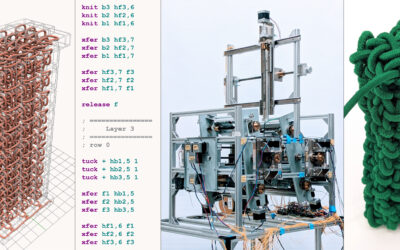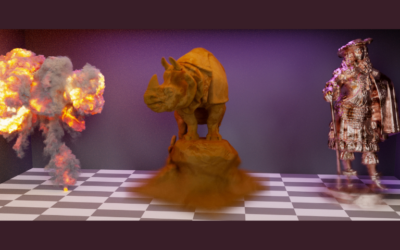“Image Objects: An Archaeology of Computer Graphics” Ⓒ Jacob Gaboury
As we dive deeper into the digital age, it’s easy to forget the history and origins of the technology that surrounds us. Jacob Gaboury, author of “Image Objects: An Archaeology of Computer Graphics” and 2022 Computer History Museum Book Prize winner, delves into the forgotten past of computer-generated images and their impact on our present and future. His enlightening research has uncovered fascinating insights into the evolution of computer graphics and its role in shaping our modern world. In this interview, we sit down with Gaboury to discuss his book, the history of computer graphics, and his career as a media historian.
SIGGRAPH: Congratulations on winning the 2022 Computer History Museum Book Prize for “Image Objects: An Archaeology of Computer Graphics”! What does this recognition mean to you, and how will it impact your future work in the field of computer graphics research and education?
Jacob Gaboury (JG): Thank you so much! The prize means a lot to me, especially since this project was supported for so many years by grants and fellowships from the computer science and history of computing communities. As a media historian, it was very important to me that the book was not only interesting and told an important story, but that it got the technology right and translated it into language that could be understood by specialists and non-specialists alike. This isn’t always easy, especially when dealing with computers from more than 50 years ago. The fact that it has resonated in this way is really important to me. The prize has pushed me to build new research projects related to the history of computer graphics, and I’m currently preparing a new project on the history of the computer screenshot and other techniques for visual output in the early history of computing. My goal is to write a new book that not only tells us more about the history of early graphics, but also connects that work to contemporary digital image cultures and the unique ways that they use computer images today.
SIGGRAPH: In your book, you explore the tension between “image” and “object” in computer graphics. How does this tension manifest in contemporary digital culture, and what implications does it have for our understanding of digital media, reality, and representation?
JG: I think for many artists and researchers, the idea that computer graphics are not just representational images but are, in fact, virtual objects that exist prior to being rendered into a human-legible visual form is a bit obvious. Using any 3D software, you immediately get the sense that computer graphics are vastly different from other visual media such as film and photography, even though the goal of so much research is to simulate the appearance of these older visual forms. But for many people, this is a real surprise, and so the book begins by examining the unique materiality of computer graphics, which exist simultaneously as a set of virtual objects and an image that is rendered out from them. That said, the book also shows that the object logic of computer graphics has a much broader influence than Pixar movies and video games. This is because computer graphics were central to the development of object-oriented programming and design as early as the 1960s, leading to all kinds of object-oriented systems that are central to contemporary computing cultures. Looking at graphical objects in this way, my goal is to show readers that many of the objects they encounter in their daily lives — objects that may not appear digital in any way — have in fact been shaped by the history of computer graphics. From architecture to industrial design and desktop publishing, our world is filled with objects that are part of this history even if they don’t appear to be at first glance. My hope is that the book provides us with new abilities to see the world differently and to understand that computer graphics aren’t just pretty pictures, they are central to the history of computer science as a whole, and in many ways, they have remade the world in their image.
SIGGRAPH: In your research, what did you find to be the most surprising or unexpected discovery related to the history and development of computer graphics technology?
JG: The thing that surprised me most was that computer graphics were so much older than I had ever imagined. Most of us think of computer graphics as a relatively recent technology that comes after the development of most other computer science applications. This is because our first experience of computer graphics is often in popular media, such as film or video games. What surprised me most when I began this project was that computer graphics are as old as some of the first-stored program computers, and that from the very beginning scientists were interested in using the computer to make images. Even more surprising was the fact that so much of this history took place at institutions outside of the dominant research hubs of the east and west coasts like MIT or Silicon Valley. This is why my book focuses primarily on the University of Utah in Salt Lake City where so many of the basic concepts for 3D computer graphics were developed and where the majority of my archival materials come from.
SIGGRAPH: In addition to your research and writing, you have also worked on several multimedia projects related to computer graphics and digital art. Could you talk a bit about these projects, and how they relate to your broader research interests?
JG: Prior to my work on the history of computer graphics, I worked on contemporary digital art in New York City with organizations like Rhizome and Eyebeam, and I am still very interested in contemporary artists using computer graphics and other digital tools to push the boundaries of the medium. While a lot of contemporary computer graphics research is directed toward photorealism and lifelike simulation, a lot of artists are exploiting these tools to make work that explicitly refuses realism, and in doing so reveals a lot of the messy work that goes into computer graphics that we normally try to hide. In my book, I’m somewhat critical of the so-called “quest for realism” that drove so much early research into computer graphics and remains an animating fantasy of the field, and so I find this kind of artwork that exploits graphical tools to create surreal and abstract images fascinating and important. While “Image Objects” is not explicitly invested in this work, as there are already many wonderful books about the history of computer art, I found that the book resonates with many artists who are looking for a theory of computer graphics that speaks to the work they do.
SIGGRAPH: You have been involved with SIGGRAPH in the past. Talk about your experience with SIGGRAPH, and what benefits you see in participating in this community.
JG: I’ve spoken at SIGGRAPH twice now and hope to again in the future. Most of my work with SIGGRAPH has been with education and outreach, both with initiatives around making computer graphics history public and through the Diversity and Inclusion Summit where I have presented some of my other research on the work of important queer and trans* figures in the history of computing. Computer science is a unique field of scientific research, in that its deep investment in technological improvement and future-oriented thinking means it often does not stop to consider its own history. Many computer science programs have no historical requirements, and so we often find ourselves reinventing the wheel without learning from the mistakes and innovations of the past. It has been incredibly important for me to participate in SIGGRAPH as someone thinking about this history and what it can tell us about the kinds of research we are doing today, while also getting a front-row seat to that research as it unfolds.
SIGGRAPH: What advice do you have for individuals who are interested in pursuing a career in the field of computer graphics and visual culture? Are there any particular skills or experiences that you think are especially important to cultivate in this field?
JG: I can’t necessarily speak to what it takes to be a successful computer graphics researcher, but I certainly can say a few things about being a computer historian. Perhaps most importantly, our job is one of translation. Translating the technical work of computer science into language that is accessible to a general audience, for one, but also translating the work of computer scientists in ways that may not be apparent to those same scientists, even when we are describing their own lives and work. Developing the ability to step outside dominant narratives that science tells itself about how the world works is essential to see the bigger picture. Our job is not only to tell the history of computing as our subjects remember it, but to ask what those narratives mean and how they influence the world. Of course, it is important to talk to the people who were there, especially while so many significant figures are still alive and willing to speak. But scientists can and often do write their own biographies and experiences, and our job is to look beyond those experiences and describe what they say about the world.
SIGGRAPH: Lastly, what are your future career goals, and what projects or initiatives are you currently working on that you are particularly excited about?
JG: I’m currently working on two projects. The first is a history of the computer screenshot and related techniques for visual output over the past 70 years. Screenshots are some of the most popular and widespread digital image genres today, but 50 years ago, taking an analog photo of a computer screen was one of the only ways to get a digital image off of a computer and into the world. These images were used in scholarly articles and magazines and helped researchers who did not have access to high-end computational machines to understand the cutting-edge of contemporary research and to imagine what the future might hold. I’m interested in thinking about the influence of these early techniques on contemporary screenshot cultures and their implications for how we archive and preserve our digital lives through these images today. I’m also continuing to work on the history of queer and trans* figures in computer science and the importance of thinking about and acknowledging the complex and personal lives of the many figures beyond Alan Turing that shaped the history of the field.
Don’t forget to submit your work to SIGGRAPH 2023! Programs like Frontiers, Posters, Electronic Theater, and Real-Time Live! are still accepting contributions to be considered for the 50th SIGGRAPH conference. Submit yours now.

Jacob Gaboury is an associate professor of film and media at the University of California at Berkeley, specializing in the 70-year history of digital image technologies and their impact on our contemporary visual culture. His first book was published in 2021 with MIT Press and is titled “Image Objects: An Archaeology of Computer Graphics.” The book tells the early history of computer graphics through the archives of the pioneering research program at the University of Utah, one of the most important sites in the development of 3D graphics from roughly 1965-1980. This work was supported by numerous fellowships from institutions across the humanities, sciences, and the arts, including the Association of Computing Machinery (ACM), the Institute of Electrical and Electronics Engineers (IEEE), the Smithsonian Institute, the Charles Babbage Institute, and the Max Planck Institute for the History of Science. His work has appeared in a range of popular and scholarly publications, including “Grey Room,” the “Journal of Visual Culture,” “Rhizome,” “Art Papers,” and “Camera Obscura.”



